By Jeffrey A. Rendall, Photos By Jeffrey A. Rendall
EASTON, MD – When it comes to playing golf, we’re hardly creatures of habit.
There’s nothing quite as boring or un-interesting as playing the same course over and over again, with the same basic pin positions, the same playing strategy and the same lack of mental stimulation from the bland landscape. If your local course is like that, you’re just as well staying home and watching a re-run of the Oprah Winfrey show.
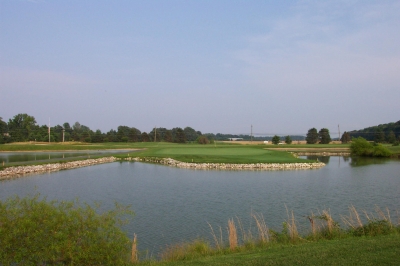 |
| Not many courses have an island hole, but the Easton Club does -- the 171 yard, par three 11th hole. |
That’s why it’s refreshing to see a course like The Easton Club, located in the town of the same name in Talbot County on Maryland’s eastern shore. The Easton Club opened in 1995, designed by long-time Easton resident Bob Rauch, and it serves as a semi-private club to a healthy local membership, as well as welcoming walk-on public play.
The course winds in and amongst a residential housing development, and its relatively compact setting gives it the air and feel of a private club. It’s got a plethora of interesting holes, is well maintained, and is very quiet – almost like a resort golf experience without the condos and villas surrounding the holes, or the hordes of hackers guaranteeing a five and a half hour round.
But it’s also the fact that the course changes from day-to-day that keeps ‘em coming back, according to the Easton Club’s Head Golf Professional, Jeff Smith: “The thing I want our players to remember most when they’ve played here a few times is that it’s not a ‘cookie-cutter’ golf course -- that the next time they come back they could very easily attack the course in a different way, and probably score better.”
Smith continues, “I’ve worked at some really beautiful courses in my life, but what makes this club so much fun, is the length and set-up of the course allows for quite a few options from the tee. I’ve been to some courses where you’ll name a hole, and you’ll automatically think – ‘I’ll hit driver, three-wood, 8-iron.’ Well, you can’t do that here, because with the wind conditions and layout, you have to know when to gamble and when to play it short and safe.”
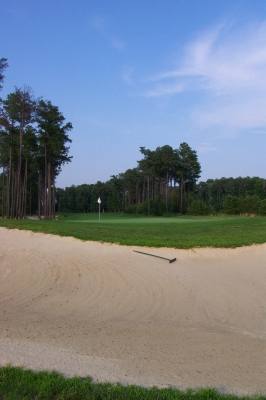 |
| Looking from in back of the par four 3rd hole. It's the Easton Club's #1 handicap hole, and is deserving of the designation. It's long and narrow. |
In all fairness, most courses I’ve been to provide very similar options, but Smith’s got a point in particular about the Easton Club. The back tees measure only a yard over 6,500, yet the course still offers four par fives (par 71). All four are arguably reachable in two – but on a couple of those, you’ve got to hit it pretty much dead-straight on both shots to earn an eagle putt.
As Smith mentions above, better save the cookie-cutter cravings for some other place. Here, it’s probably even preferable to tee with a mid-iron at times to keep it in play.
“The course sets up in two different mind-sets,” Smith explained, “because obviously there’re some open holes, and there’re some cut through trees. If you’re not willing to get a little creative – get beyond the scorecard yardage, you’ll find yourself in trouble a lot. You’ve got to be willing to use all fourteen clubs in your bag, and I think you’ll be a lot more satisfied.”
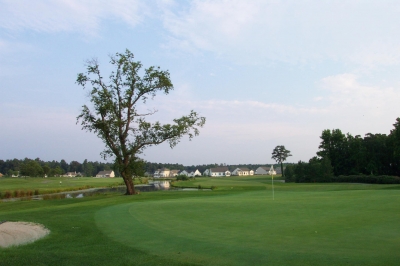 |
| Looking back at the 548 yard, par five 18th hole. |
He’s right. Each cart contains a yardage guide, and I’d suggest that you use it to play shots to a pre-determined destination – and I’d also caution against thinking you’ll be making good use of Big Bertha on this course. Smith might’ve said fourteen clubs in the last paragraph, but I’d recommend that you play with the thirteen ‘smallest,’ unless you’ve got Fred Funk’s accuracy from the tee.
Even if you’re a bit off-line you won’t be adding many penalties (or losing many golf balls), however. Part of the reason is the conditioning of the golf course, as well as the staff’s diligent hard work over the years to clear the underbrush in the forested areas. There were a few times that I reached the pine-straw, and thankfully, punching back to play only costs one stroke.
Consistency’s also the key. “We take tremendous pride in making the playing surfaces consistent for all eighteen holes. To say it’s in great shape is one thing, but we have some holes where if the speed of the green doesn’t equate with what you’ve been seeing, you’ll have difficulty with the slopes. We also want to make sure the height of the rough and the bunker sand are the same throughout,” Smith said.
“This club is almost ten years old now, and the people who’ve been here from the start know that during our first few seasons, if you missed the fairways, the hard soil would leave you bouncing, sometimes in crazy directions. I’m glad to say we’re grown in nicely now. We want to provide those pristine conditions for our members, but we also think it’s important that public players get the same outstanding impressions,” Smith added proudly.
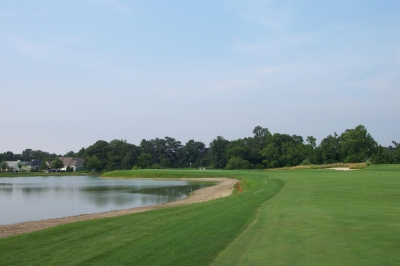 |
| There isn't a ton of water at the Easton Club, but what there is, is strategically placed. Here, the view of the third shot on the par five 6th hole. |
The Easton Club’s fees are about mid-range for the DC area, actually on the low side for upscale courses. You won’t be teeing over yawning ravines and marvel at stunning waterfront vistas, but the playing conditions are excellent for the money. Smith gives credit to the superintendent and staff, and so do we.
As alluded to above, the Easton Club ‘feels’ a bit like a private club. Part of that is from the layout of the holes, part of it’s from the facilities, and part of it’s from the attitude of the staff.
Smith puts it better: “We pride ourselves on a very full-service pro shop here. We probably have the most diverse shop in the area, as far as different clubs we carry, different styles and manufacturers of clothing, lesson programs, fitting programs…”
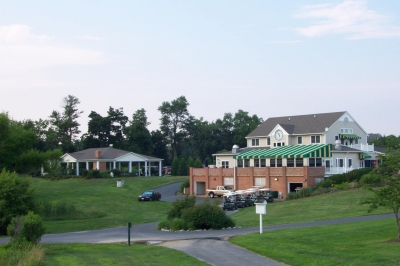 |
| The Easton Club's clubhouse. |
“We’re also attached to a very nice restaurant (Martinis). Even though it’s not technically part of the club, it’s all part of the day we provide our players – they can get a sandwich or stay for dinner,” Smith added.
It’s true. Eats are important, and though I didn’t try take advantage of the restaurant, it certainly looked (and smelled) inviting.
But it’s more than just pleasant looks, service and smells. Again, it’s ‘feel’ at the Easton Club.
“A lot of people, when they first see the Easton Club probably think it’s just another neighborhood, residential golf course – and in the past, that’s kind of thrown us in a gray area. It doesn’t look like a public course, and the service, I think, is much better. We’ll work extra hard to alleviate that ‘outsider’ feeling – and once our visitors step through the door, they realize this is both public and member friendly, and we’ll treat everyone equally well,” Smith said.
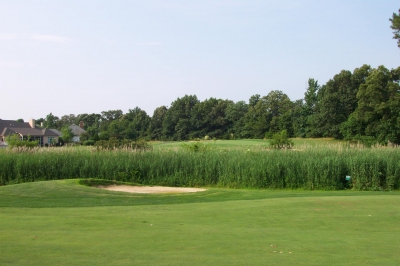 |
| Here's a look from the fairway on the par four 8th hole. If you've positioned your ball well off the tee, you'll only have a short pitch over the wetlands. |
The layout itself contains a nice variety of holes, the vast majority of which won’t require Daly-like distance. There’re only two par fours over 400 yards (even from the back tees), and most tee landing areas are nicely guarded by trees, bunkers or ponds to ensure accuracy. Like its neighbor to the west, Harbourtowne Resort, the Easton Club is very much of a target-oriented shot-maker’s course.
The par threes are all different, too – from the 227-yard, fourth hole to the 171-yard, island green eleventh hole. Different distances, different clubs from the tee, different shots. No cookies here, folks.
Hole highlights include the seventh hole, the shortest par three on the course at 160 yards (named ‘Blue Crab’). It’s not technically an island green, as there’s no water, but it seems like an ‘island’ once you’re on it – you’ll have to carry an environmental area, and there’s not a great deal of room to miss in any direction. The green is good sized, and there’s at least a two club difference between front and back pin positions. Not a tremendously difficult test, but one you’ll be glad to leave with a par.
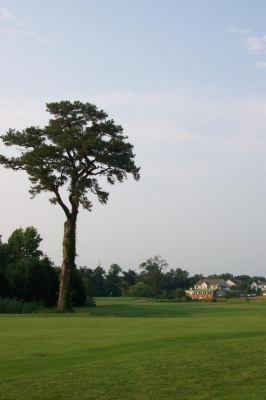 |
| A large tree guards the corner of the dogleg on the par five 18th hole. |
The eighth hole is one of those par fours that will make you think. Only 379 yards in length, there’s a somewhat narrow landing zone with an environmental area on the right, and the hole sharply doglegs right for the second shot. There’s also a tree that impacts the landing area – you certainly don’t want to be behind it.
On the back, you’ll definitely remember the ‘true’ island green, the eleventh hole. The tee box marks the highest point on the golf course, which gives you a nice downhill shot, but also brings the wind into play – and there’s a lot of water all around. Unlike most island holes, there’s quite a bit of land to shoot at.
The finishing par five is the best three-shotter on the course. There’s a fairly wide landing area for the tee shot, but the challenge starts with the final 300 yards of the hole. There’s water up the right side, forest on the left, and another large tree to the right of the putting surface (that really won’t influence much except for a back-right pin placement).
As you’re finishing up, you’re right in front of the Easton Club clubhouse. There’s a large clock that you can see, which is appropriate for this type of golf facility – because time doesn’t really matter that much when you’re having such a good time.
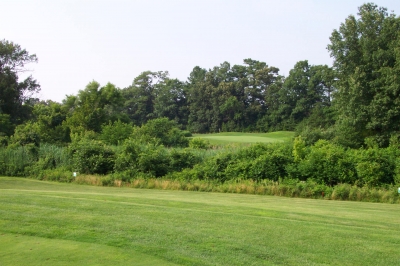 |
| It's kind of hard to see, but the par three 7th hole's green is back there somewhere. It's not a long shot, but it sure is intimidating with all the lush greenery between you and the flagstick. |
The Easton Club won’t ‘wow’ you in the visual sense like a lot of the newer courses these days, but if you’re looking for a pleasant, ‘country club’ type golf outing with some friendly folks serving you (and a good value), there’s hardly anything better.
Where We Stayed
Seeking to take advantage of the historic and cultural offerings of beautiful Talbot County, we stayed at The Tidewater Inn in Easton, just a short drive from the Easton Club.
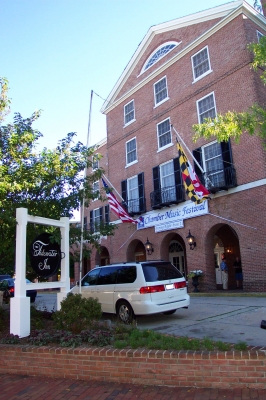 |
| The Pride of the Eastern Shore, The Tidewater Inn. |
The Tidewater Inn calls itself the ‘Pride of the Eastern Shore,’ and that’s no exaggeration. You’ll enter through beautiful mahogany doors into a lobby richly decorated as a fine private historic home – this is definitely not your average hotel.
Guest rooms are equally tastefully decorated with fine antique reproductions and fabrics. We particularly enjoyed the striking Colonial color patterns. With all the amenities of a fine hotel, you’ll feel like you’re in a historic building without foregoing the comforts and conveniences of the 21st century.
Located in downtown Easton, the Tidewater Inn is convenient to shopping, sight seeing, diverse sporting opportunities (including golf) and a wealth of restaurants nearby. It’s also surprisingly family friendly, with an outdoor pool on site.
The Tidewater Inn also can accommodate business or private groups and wedding receptions up to 300 people, with extensive conference rooms and facilities.
For more information on the Tidewater Inn’s offerings and reservations, try their website: www.Tidewaterinn.com, or call (800) 237-8775.
Details:
The
Phone: (410) 820-9800; Toll Free: (800) 277-9800
Website: www.eastonclub.com
Course Designer: Bob Rauch
Head Golf Professional: Jeff Smith
Superintendent: Bill Redmond
Tees/Yardage (par 71)/Slope/Rating
Black 6501 126/71.3
Blue 6036 123/69.5
White 5504 117/66.5 -- 121/72.4 (L)
Red 5028 118/69.8
Rates:
$49 M-Th. $39 at 2 o’clock, and $25 at four.
$59 Fri-Sun, $49 at 2 o’clock, and $25 at four.
Rates include cart. $3 a bucket of balls for the range, and it’s about 35 balls.
Walking is the same rate. There are a few holes with some distance between the previous green and the next tee, but on the whole, The Easton Club is very walkable, and it’s unrestricted.
| Related Links | Comments on this article? | |
|
Maryland National Golf Club Hollow Creek Golf Club Rocky Gap Resort PB Dye Golf Club in Ijamsville Whiskey Creek Golf Club |
E-mail Jeff Rendall, Editor: jrendall@golftheunitedstates.com |











